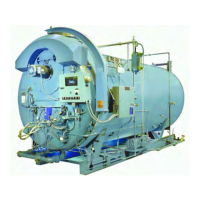Chapter 6 — Adjustment Procedures
Part No. 750-184 6-23
Note: All adjustment should be done by a qualified boiler
operator or your local Cleaver-Brooks Service
representative.
Burner efficiency is measured by the amount or percentage of O
2
present in the flue gas. O
2
readings determine the total amount or
excess air in the combustion process, above the point of
stoichiometric combustion or perfect combustion. Stoichiometric
combustion however, is the reference point used when setting fuel/
air ratios in a boiler.
There must always be excess air in the combustion process to
account for changes in boiler room conditions and to ensure the
combustion is on the proper side of the combustion curve.
Proper setting of the air/fuel ratios at all rates of firing must be
established by the use of a combustion gas analyzer. Efficient
combustion cannot be solely judged by flame condition or color,
although they may be used in making approximate settings.
Combustion settings should be done so that there is a bright sharp
flame with no visible haze.
Most flue gas analyzers in use today measure the content, by
percentage, of oxygen (O
2
) and in some cases, smoke. Carbon
dioxide (CO
2
) is not normally measured with modern gas analyzers,
but may be displayed as a calculation.
The O
2
levels through the entire firing range of the burner, low fire
to high fire should be tested. The burner manufactures
recommendations on turndown should also be followed and the
turndown range of the burner should not be exceeded.
It is required to set the burner to operate with a reasonable amount
of excess air to compensate for minor variations in the pressure,
temperature, or burning properties of oil. Fifteen to 20% excess air
is considered reasonable. This would result in an O
2
reading of 3%
to 4%, at high fire.
Final adjustment to fuel input must be made to produce a minimum
of smoke. A maximum smoke spot density of a No. 2 for light oil, or
a No. 4 for heavy oil is acceptable, as measured in conformance to
ASTMD 2156-63T.
Through the use of the manual flame control, slowly bring the unit
to high fire by stages while monitoring combustion for overly rich or
lean conditions. At the high fire position, the air damper should be
fully opened and the air and oil pressure readings should be within
acceptable levels.
Take a flue gas analysis reading. If necessary, adjust the fuel oil
controller to increase or decrease oil pressure. Adjustments to the
pressure should be done before attempting to adjust the screws in
the metering cam. Ideally, the cam profile spring should be as close
to the cam casting as practical. It is more desirable to lower the oil
pressure to reduce flow, if necessary, than to extend the adjusting
screws to an extreme position in an effort to cut back flow.
After being certain that the air control damper and its linkage are
operating properly, final adjustment can be made, if necessary, to

